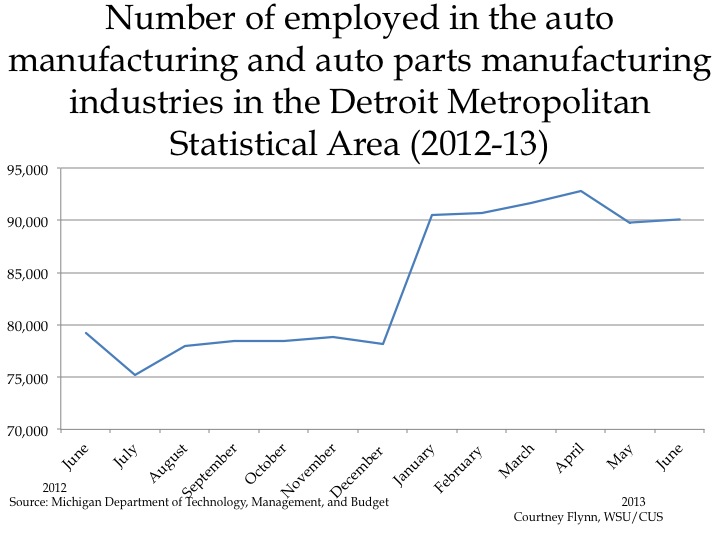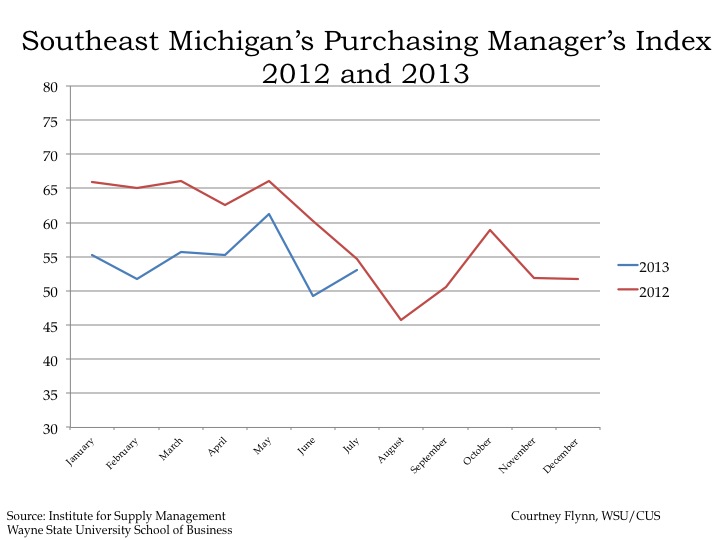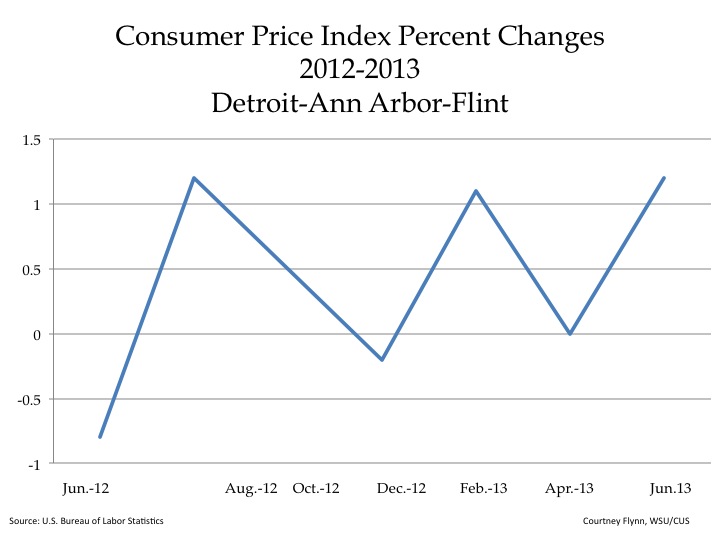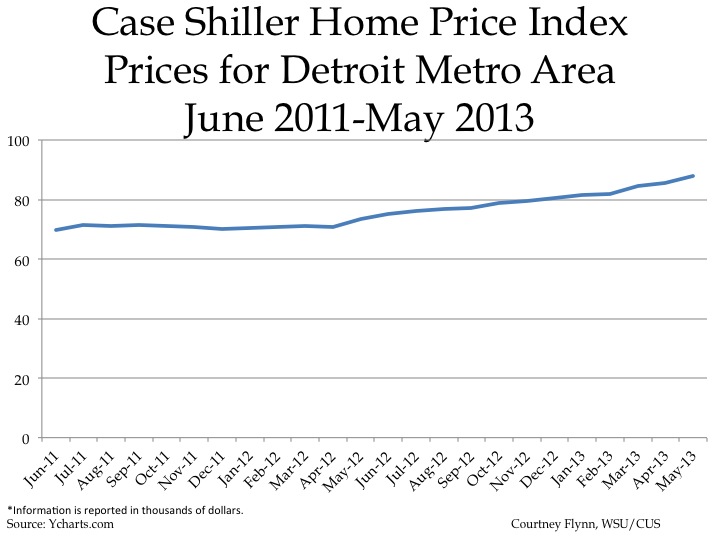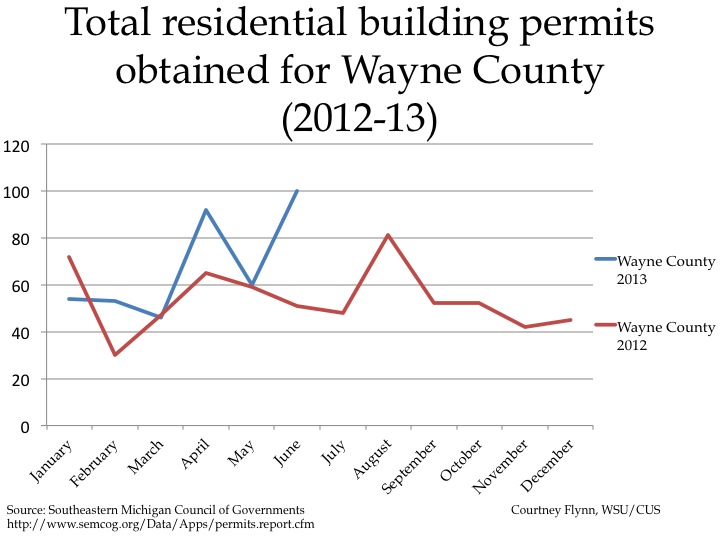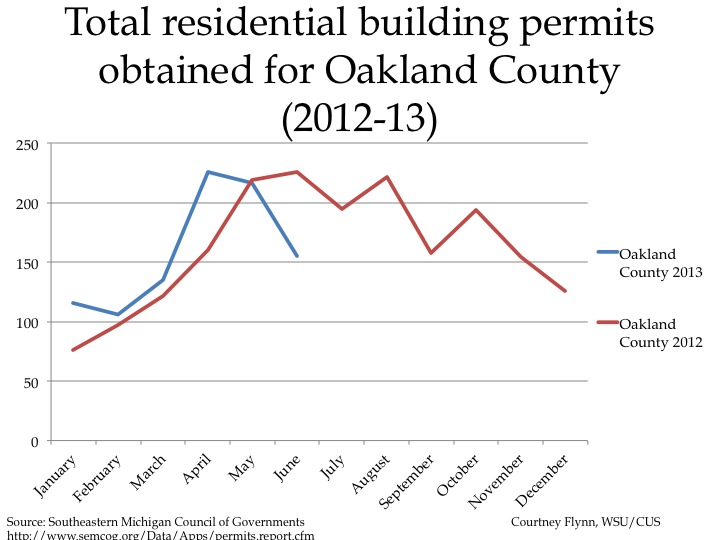According to the most recent data provided by the Michigan Department of Technology, Management and Budget, there was a 0.3 percent increase in the unemployment rate for the State of Michigan between June 2013 and July 2013; in July 2013, the rate was 9.7 per 100 people. For the City of Detroit, the unemployment rate remained constant from May 2013 to June 2013 at 16.3 percent.
In June 2013, there were 282,129 people (both residents and non-residents) employed in the City of Detroit, which was a decrease of 1,379 people from May 2013.
The above chart shows the number of people employed in the auto and auto part manufacturing industries in the Detroit Metropolitan Statistical Area (MSA) from June 2012 to June 2013. There was only a small increase in the number workers employed in these industries from May 2013 to June 2013. However, between July 2012 and June 2013, there was an increase of 14,900 persons.
The Purchasing Manger’s Index (PMI) is a composite index derived from five indicators of economic activity: new orders, production, employment, supplier deliveries, and inventories; a PMI above 50 means the economy is expanding.
According to the most recent data released on Southeast Michigan’s Purchasing Manager’s Index, there was an increase of 2.9 points from June 2013 to July 2013; in July 2013, it was recorded at 53.1. The PMI of 53.1 is reflective of an increase in production activity and new orders.
Since the beginning of 2012 the PMI has indicated an expanding economy, aside from August 2012 and June 2013.
The Commodity Price Index, which is a weighted average of selected commodity prices, was recorded at 54.8 in July 2013, which was 4.7 lower than the previous month. The July 2013 value (54.8), however, was 5.7 points higher than the July 2012 value (49.1).
The Consumer Price Index measures the change in prices in a fixed market. The index is based on prices of “food, clothing, shelter, fuels, transportation fares, charges for doctors’ and dentists’ services, drugs, and the other goods and services that people buy for day-to-day living,” according to the Bureau of Labor Statistics.
The above graphs show the percent change in the price index measurements. The first graph shows there was a 1.2 percent increase in the overall Consumer Price Index from April to June 2013 in the Detroit-Ann Arbor-Flint area. According to the Bureau of Labor Statistics, this is mainly based on the fact that energy costs increased by 6.6 percent over the three month time period.
For the Consumer Price Index Less Food and Energy, there was a 0.6 percent increase in the index from April to June 2013. This change was smaller than the overall Consumer Price Index percent increase.
The above charts show the Standard and Poor’s Case Shiller Home Price Index for the Detroit Metropolitan Statistical Area. The index includes the price for homes that have sold but does not include the price of new home construction, condos, or homes that have been remodeled.
According to the index, the average price of single-family dwellings sold in Metro Detroit was $87,990 in May 2013. This was an increase of approximately $18,300 from the average price in June 2011.
Like the Home Price Index, the annual percent change in the Home Price Index also showed an overall increase since June 2011. Between May 2012 and May 2013, there was a 19.16 percent increase in home prices for the Detroit MSA.
The above charts show the number of residential building permits obtained each month in Wayne, Oakland, and Macomb counties from January 2012 until June 2013. These numbers are reported by local municipalities to the Southeastern Michigan Council of Governments and include single family, two family, attached condo, and multi-family units.
Of the three counties examined, Wayne County was the only county that experienced an increase in the number of permits obtained from May to June in 2013 (an increase of 40 permits). The number obtained in Oakland County decreased by 64 from May to June and the number for Macomb County decreased by 30.
When comparing the number of permits obtained in June 2012 versus June 2013 for these three counties, Macomb and Wayne counties showed increases, 98 and 49 respectively. There was a decrease of 71 permits for Oakland County.
In June of 2013 there were 100 building permits pulled in Wayne County, 155 pulled in Oakland County and 187 pulled in Macomb County.


